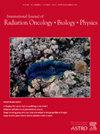Generalizable Magnetic Resonance Imaging-based Nasopharyngeal Carcinoma Delineation: Bridging Gaps Across Multiple Centers and Raters With Active Learning
IF 6.4
1区 医学
Q1 ONCOLOGY
International Journal of Radiation Oncology Biology Physics
Pub Date : 2024-11-16
DOI:10.1016/j.ijrobp.2024.11.064
引用次数: 0
Abstract
Purpose
To develop a deep learning method exploiting active learning and source-free domain adaptation for gross tumor volume delineation in nasopharyngeal carcinoma (NPC), addressing the variability and inaccuracy when deploying segmentation models in multicenter and multirater settings.
Methods and Materials
One thousand fifty-seven magnetic resonance imaging scans of patients with NPC from 5 hospitals were retrospectively collected and annotated by experts from the same medical group with consensus for multicenter adaptation evaluation. One data set was used for model development (source domain), with the remaining 4 for adaptation testing (target domains). Meanwhile, another set of 170 patients with NPC, with annotations delineated by 4 independent experts, was created for multirater adaptation evaluation. We evaluated the pretrained model's migration ability to the 4 multicenter and 4 multirater target domains. Dice similarity coefficient (DSC), 95% Hausdorff distance (HD95), and other metrics were used for quantitative evaluations.
Results
In the adaptation of dataset5 to other data sets, our source-free active learning adaptation method only requires limited labeled target samples (only 20%) to achieve a median DSC ranging from 0.70 to 0.86 and a median HD95 ranging from 3.16 to 7.21 mm for 4 target centers, and 0.78 to 0.85 and 3.64 to 6.00 mm for 4 multirater data sets. For DSC, our results for 3 of 4 multicenter data sets and all multirater data sets showed no statistical difference compared to the fully supervised U-Net model (P values > 0.05) and significantly surpassed comparison models for 3 multicenter data sets and all multirater data sets (P values < 0.05). Clinical assessment showed that our method-generated delineations can be used both in multicenter and multirater scenarios after minor refinement (revision ratio <10% and median time <2 minutes).
Conclusions
The proposed method effectively minimizes domain gaps and delivers encouraging performance compared with fully supervised learning models with limited labeled training samples, offering a promising and practical solution for accurate and generalizable gross tumor volume segmentation in NPC.
基于核磁共振成像的鼻咽癌划定:通过主动学习缩小多个中心和评分者之间的差距
目的:开发一种利用主动学习和无源域自适应的深度学习(DL)方法,用于鼻咽癌(NPC)的肿瘤总体积(GTV)划分,解决在多中心和多评分者设置中部署分割模型时的可变性和不准确性。其中一个数据集用于模型开发(源域),其余四个数据集用于适应性测试(目标域)。同时,我们还建立了另一个 170 例鼻咽癌患者数据集,由四位独立专家进行注释,用于多方适应性评估。我们评估了预训练模型迁移到四个多中心和四个多评分者目标域的能力。我们采用了骰子相似系数(DSC)、95% Hausdorff 距离(HD95)和其他指标进行定量评估:在将数据集 5 改编为其他数据集时,我们的无源主动学习改编方法只需要有限的标注目标样本(仅 20%),就能使四个目标中心的 DSC 中值从 0.70 到 0.86 不等,HD95 中值从 3.16 毫米到 7.21 毫米不等;四个多评分者数据集的 DSC 中值从 0.78 到 0.85 不等,HD95 中值从 3.64 毫米到 6.00 毫米不等。在DSC方面,我们对四个多中心数据集中的三个数据集和所有多评分者数据集的结果显示,与完全监督的U-Net模型相比没有统计学差异(P值>0.05),而对三个多中心数据集和所有多评分者数据集的结果则明显优于比较模型(P值<0.05)。临床评估结果表明,我们的方法生成的划界在稍作改进后(修订率小于 10%,中位时间小于 2 分钟),可用于多中心和多评分者情况:结论:与标注训练样本有限的完全监督学习模型相比,所提出的方法有效地减少了领域差距,并提供了令人鼓舞的性能,为准确和可推广的鼻咽癌 GTV 分割提供了一种前景广阔的实用解决方案。
本文章由计算机程序翻译,如有差异,请以英文原文为准。
求助全文
约1分钟内获得全文
求助全文
来源期刊
CiteScore
11.00
自引率
7.10%
发文量
2538
审稿时长
6.6 weeks
期刊介绍:
International Journal of Radiation Oncology • Biology • Physics (IJROBP), known in the field as the Red Journal, publishes original laboratory and clinical investigations related to radiation oncology, radiation biology, medical physics, and both education and health policy as it relates to the field.
This journal has a particular interest in original contributions of the following types: prospective clinical trials, outcomes research, and large database interrogation. In addition, it seeks reports of high-impact innovations in single or combined modality treatment, tumor sensitization, normal tissue protection (including both precision avoidance and pharmacologic means), brachytherapy, particle irradiation, and cancer imaging. Technical advances related to dosimetry and conformal radiation treatment planning are of interest, as are basic science studies investigating tumor physiology and the molecular biology underlying cancer and normal tissue radiation response.

 求助内容:
求助内容: 应助结果提醒方式:
应助结果提醒方式:


